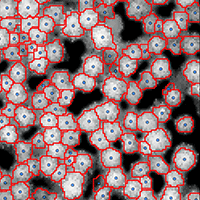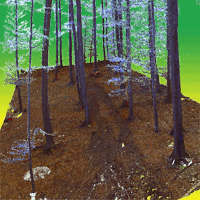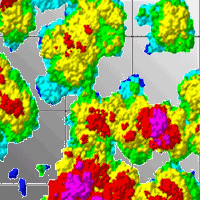
Use of LIDAR-based digital terrain model and single tree segmentation data for optimal forest skid trail network
Krzysztof Sterenczak (1), Tadeusz Moskalik (2)
iForest - Biogeosciences and Forestry, Volume 8, Issue 5, Pages 661-667 (2014)
doi: https://doi.org/10.3832/ifor1355-007
Published: Dec 22, 2014 - Copyright © 2014 SISEF
Research Articles
Abstract
The implementation of rational forest management that takes into consideration the requirements of sustainable forest development requires many decisions to be made, ranging from simple rules to extremely complex procedures. This is also true of logging operations, where the applied techniques and technologies should relate not only to economic aspects, but also be maximally adapted to the specific forest environment. One of the most important determinants of environmentally safe and effective logging work is forest accessibility through an appropriately planned road and skid trail network. This paper presents the possibilities of using the Airborne Laser Scanner (ALS) and Geographic Information System (GIS) to determine the optimal or near-optimal locations of forest skid trails. Choosing skid trails depends on the adopted logging method, existing road network, forest stand development phase, and terrain conditions. The process of optimization takes into account existing stand gaps to reduce the number of trees that must be removed for the network. Segments representing single trees and the Digital Terrain Model (DTM) served as inputs for the GIS analysis. The research was carried out in Scots pine stands. The obtained results show that the total length of skid trails, with 40 m distance between them, after optimization for traditional harvesting method decreased by 2%. For fully mechanized harvesting method, the skid trail network was decidedly denser (20 m) and an original length was reduced only by 0.06%. The results obtained confirmed the practical usefulness of the adopted procedures.
Keywords
Logging, Airborne Laser Scanner, Single Tree Detection, Digital Terrain Model, Optimal Forest Skid Trail Network
Authors’ Info
Authors’ address
Forest Research Institute, Department of Information Technology and Modelling, Braci Lesnej 3, 05-090 Raszyn (Poland)
Warsaw University of Life Sciences - SGGW, Department of Forest Utilization, Faculty of Forestry, Nowoursynowska 159, 02-776 Warszawa (Poland)
Corresponding author
Paper Info
Citation
Sterenczak K, Moskalik T (2014). Use of LIDAR-based digital terrain model and single tree segmentation data for optimal forest skid trail network. iForest 8: 661-667. - doi: 10.3832/ifor1355-007
Academic Editor
Enrico Marchi
Paper history
Received: May 20, 2014
Accepted: Aug 22, 2014
First online: Dec 22, 2014
Publication Date: Oct 01, 2015
Publication Time: 4.07 months
Copyright Information
© SISEF - The Italian Society of Silviculture and Forest Ecology 2014
Open Access
This article is distributed under the terms of the Creative Commons Attribution-Non Commercial 4.0 International (https://creativecommons.org/licenses/by-nc/4.0/), which permits unrestricted use, distribution, and reproduction in any medium, provided you give appropriate credit to the original author(s) and the source, provide a link to the Creative Commons license, and indicate if changes were made.
Web Metrics
Breakdown by View Type
Article Usage
Total Article Views: 58928
(from publication date up to now)
Breakdown by View Type
HTML Page Views: 49412
Abstract Page Views: 3634
PDF Downloads: 4405
Citation/Reference Downloads: 28
XML Downloads: 1449
Web Metrics
Days since publication: 4016
Overall contacts: 58928
Avg. contacts per week: 102.71
Citation Metrics
Article Citations
Article citations are based on data periodically collected from the Clarivate Web of Science web site
(last update: Mar 2025)
Total number of cites (since 2015): 25
Average cites per year: 2.27
Publication Metrics
by Dimensions ©
Articles citing this article
List of the papers citing this article based on CrossRef Cited-by.
References
Physiographic factors and their impact on a timber extraction. In: “Proecological and productive functions of skid trails in the modern forest management”. Foundation “Development of SGGW”, Warsaw, Poland, pp. 7-13. [in Polish]
Gscholar
Allometrische studie an Pinus cembra spp. sibirica (Rupr.) Kryl. und Abies sibirica (Ledeb.) [Allometric study of Pinus cembra spp. sibirica (Rupr.) Kryl. and Abies sibirica (Ledeb.)]. Archiv für Forstwesen 17 (11): 1099-1115. [in German]
Gscholar
Planning system for road route locations in mountainous forests. Journal of the Japanese Forestry Society 66 (8): 313-319.
Gscholar
The influence of optimum road-spacing on opening up the state forest of North-Rhein Westphalia. University Regensburg, Germany, pp. 21-31. [in German]
Gscholar
A rule-based SDSS for integrated forest harvesting planning. PhD thesis, Università degli Studi di Padova, Italy, pp. 213.
Gscholar
Forest accessibility for the fully mechanized timber harvesting. In: Proceedings of the “Communication infrastructure in multifunctional sustainable forestry”. Rogow (Poland) 14 Dec 2000. Warsaw University of Life Sciences, Warsaw, Poland, pp. 81-88. [in Polish]
Gscholar
Evaluation of residual damage in felling gaps and extraction routes in single selection method (Siyakhal forest). Iranian Journal of Forest and Poplar Research 16: 87-98.
Gscholar
General principles of planning forest road nets. Food and Agriculture Organization publication, FAO, Rome, Italy, vol. 14, pp. 17-36.
Gscholar
Optimization of road layout in opening up of forests. In: Proceedings of the “Computer Supported Planning of Roads and Harvesting Workshop”. Feldafing (Germany) 26-28 Aug 1992, pp. 1-12.
Gscholar
Assessing one year pine growth at stand level with single tree detection based on ALS data. In: Proceedings of the “6th Precision Forestry Symposium: The anchor of your value chain” (Ackerman P, Gleasure E, Ham H eds). Stellenbosch University (Stellenbosch, South Africa) 3-5 March 2014, pp. 16-18.
Online | Gscholar
Development of filtering, segmentation and modeling modules for LIDAR and multispectral data as a fundament of an automatic forest inventory system. In: Proceedings of the “ISPRS Working Group on Laser-Scanners for Forest and Landscape Assessment” (Thies M, Koch B, Spiecker H, Weinacker H eds). Institute for Forest Growth, Institute for Remote Sensing and Landscape Information Systems, Freiburg, Germany, pp. 50-55.
Online | Gscholar
Principles of skid trails and landings design. In: “Proecological and productive functions of skid trails in the modern forest management”. Foundation “Development of SGGW”, Warsaw, Poland, pp. 86-97. [in Polish]
Gscholar

















